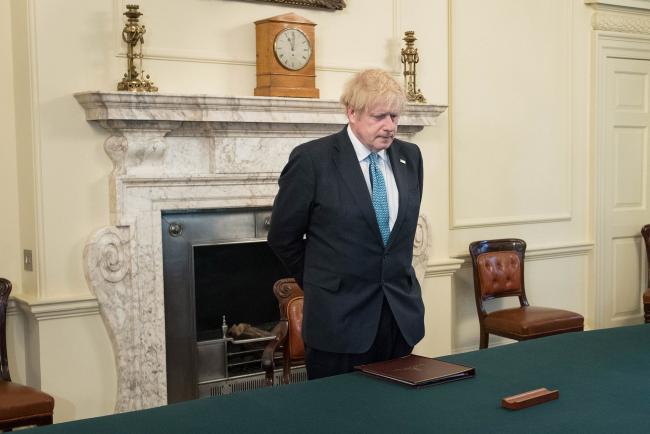This post was originally published on this site
https://d1-invdn-com.akamaized.net/content/picfb88b78315d0292ea9e72cd465083929.jpg
Prime Minister Boris Johnson put the U.K. into lockdown on March 23, telling everyone to stay at home unless they needed to go out for food or exercise, and to work from home if they could.
With the economy reeling, the prime minister has promised to set out a road-map to lifting the restrictions on Sunday, with some changes set to follow from Monday. Here’s what we know.
Big Change Isn’t Imminent
The key number to watch is “R,” the reproduction rate of the virus — how many other people each infected person passes the disease on to. Scientists and ministers need to be confident the figure is less than one. On Sunday, the estimate was that it was “around 0.7.”
When scientists were preparing different social distancing plans at the start of March, they expected them to last for between eight and 13 weeks — or through late June.
Some companies are working to that timetable: J Sainsbury (OTC:JSAIY) Plc, Britain’s second-largest grocer, has said it expects the lockdown to ease by the end of June while Nissan (OTC:NSANY) Motor Co. is planning to resume production at its plant in Sunderland, northeast England early next month.
It All Depends on Track-and-Trace
Health Secretary Matt Hancock says the key to keeping the infection rate down lies in tracking the spread of the virus and isolating people who have it as well as those who have been in contact with them. The U.K. has stepped up testing and wants to recruit 18,000 contact tracers.
The mobile phone app that will keep a record of people the owner has been in contact with won’t be ready until mid-May.
The U.K. Government’s Virus Contact-Tracing App: What We Know
A significant easing is unlikely before a lot of people have installed the app and the software is clearly working.
Workers will probably also have to wear a mask. Johnson signaled a shift in the government’s position when he spoke on April 30, saying face coverings will be “useful” to stop the virus spreading and also for “giving people confidence it’s safe to go back to work.”
The Easing Will Be Gradual
Ministers have been clear the economy can’t be switched back on all at once, so it will be done in stages. The government has written draft guides for businesses. Proposals include enforcing social distancing through tape on floors, stepped-up hygiene, staggered shifts and not sharing pens.
Businesses operating outdoors, like garden centers, where the risk of transmitting the virus is lower, are more likely to be able to open first when restrictions ease.
Some chain stores are looking at what they can do. Next Plc and Dixons Carphone (LON:DC) Plc plan to reopen their larger stores first, as it is easier to manage social distancing and crowd control.
JD (NASDAQ:JD) Wetherspoon Plc has said it is planning to reopen its pubs in or around June — but that could turn out to be optimistic. The government has said the hospitality industry will be the last to see restrictions lifted, as it is the one where it is hardest to maintain social distancing.
Some Businesses Are Already Open
B&Q, the DIY chain owned by Kingfisher (LON:KGF) Plc, has reopened all 288 of its stores as has rival Homebase, which began trading from all 164 stores over the weekend. Media reports suggested Ikea UK planned to reopen its 18 U.K. Stores on May 18. The company has not confirmed that date but said it is making extensive plans.
On Tuesday, the fast-food chain McDonalds announced the first 15 restaurants scheduled to open next week. Rival Burger King has also begun a phased reopening, starting with drive-through restaurants.
James Daunt, chief executive of Waterstones, the book store chain, said it’s ready to open as soon as it gets the green light from government. Its reopening plans include measures to keep staff and customers safe including sneeze guards at till points and trolleys located throughout the store where shoppers can discard books they have touched but do not intend to buy. These trolleys will then be wheeled into store rooms where the books can “self heal” if they happen to be be contaminated.
Re-Opening is Complicated
Even businesses that don’t serve customers in person will have social distancing issues to address: employees will need to be separated in canteens, restrooms and meeting spaces. They may also need protective equipment.
Labor unions are demanding that workers are protected properly, and the Trades Union Congress on Monday pushed back on the draft guidelines, saying they’re too “weak.”
Then there is the question of how to phase the return to work — public transport will need to return to full service early in the process to allow commuters to be spaced apart — and many parents can’t go back to work until schools re-open.
Education Secretary Gavin Williamson said last week schools in England will re-open in a “phased manner,” but he couldn’t give give a date for when they will restart. He did, though, rule out opening them during the summer vacation.
Waiting For A Vaccine
The easing plans all rest on the assumption that the virus can be contained without a full lockdown. But if infections shoot up when the brakes come off, the country may find itself back in lockdown. There may need to be a vaccine before the restrictions can be fully removed.
©2020 Bloomberg L.P.


